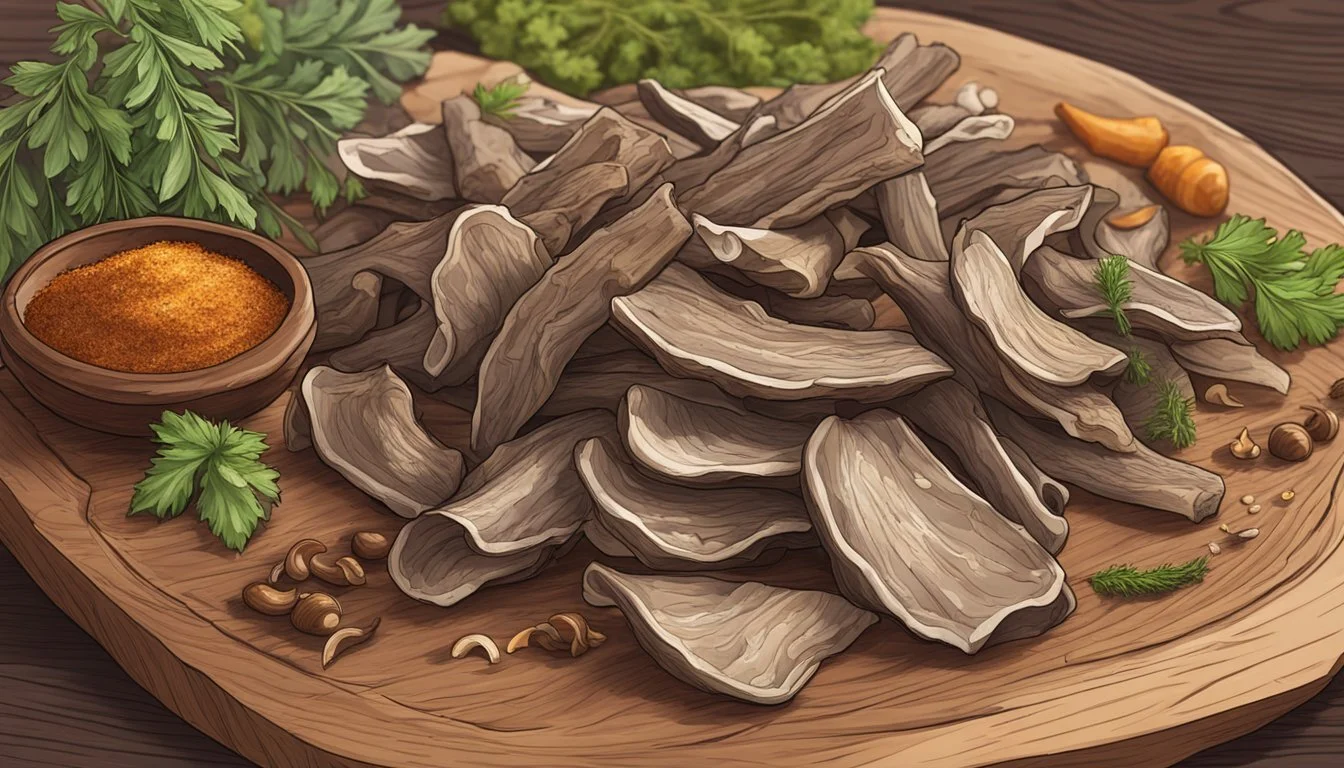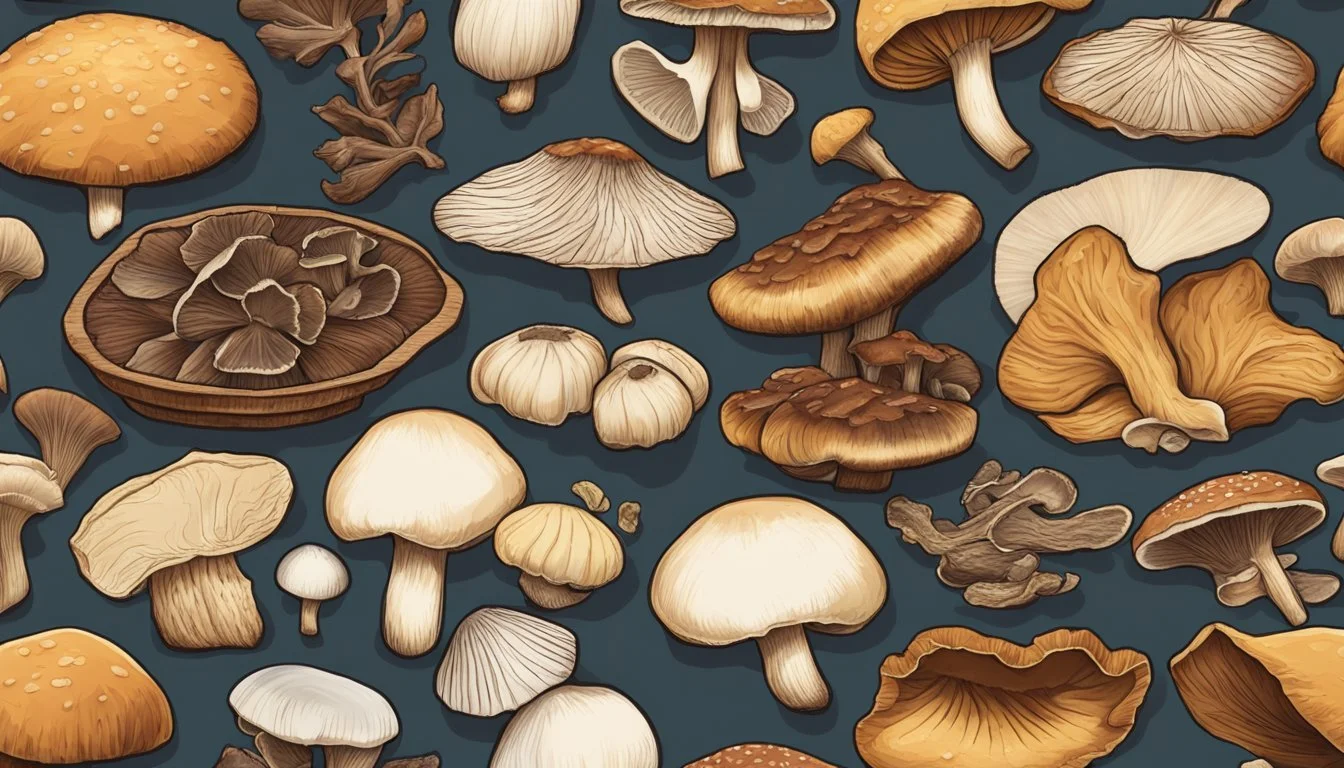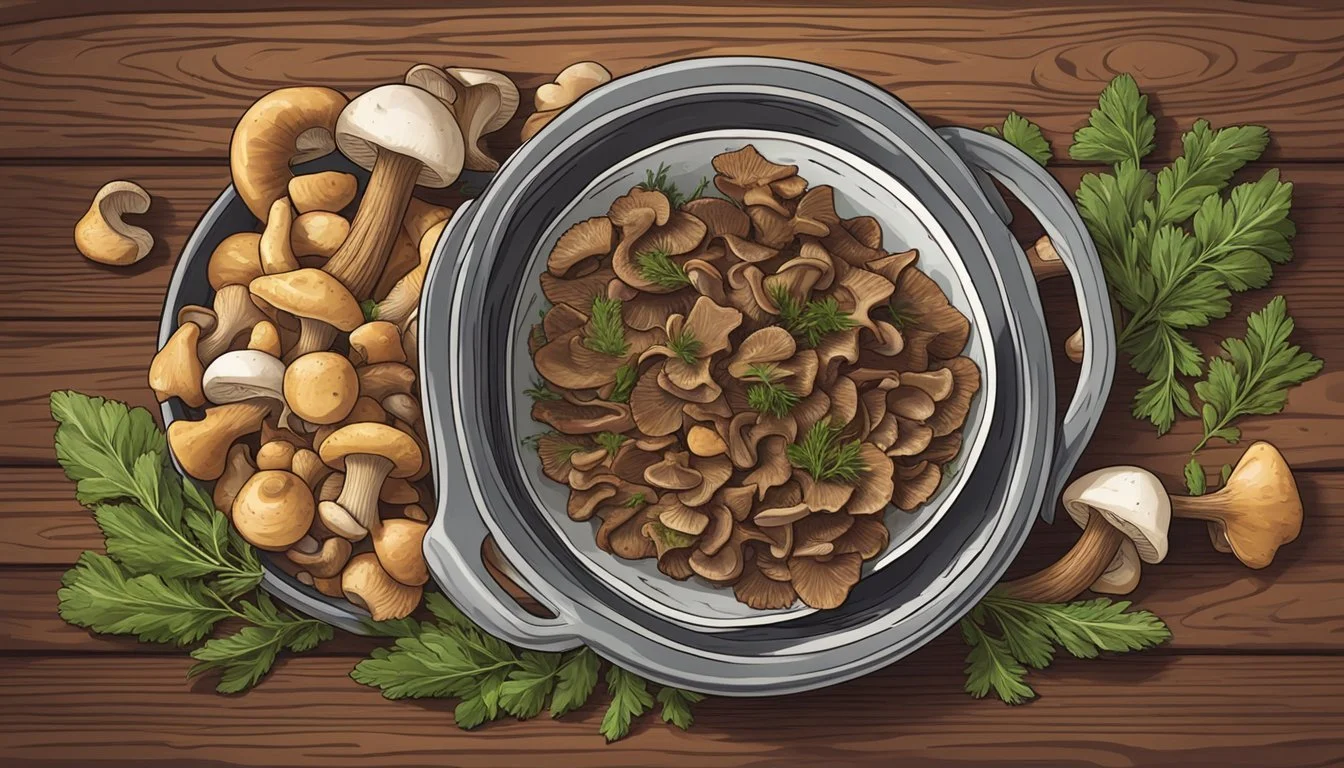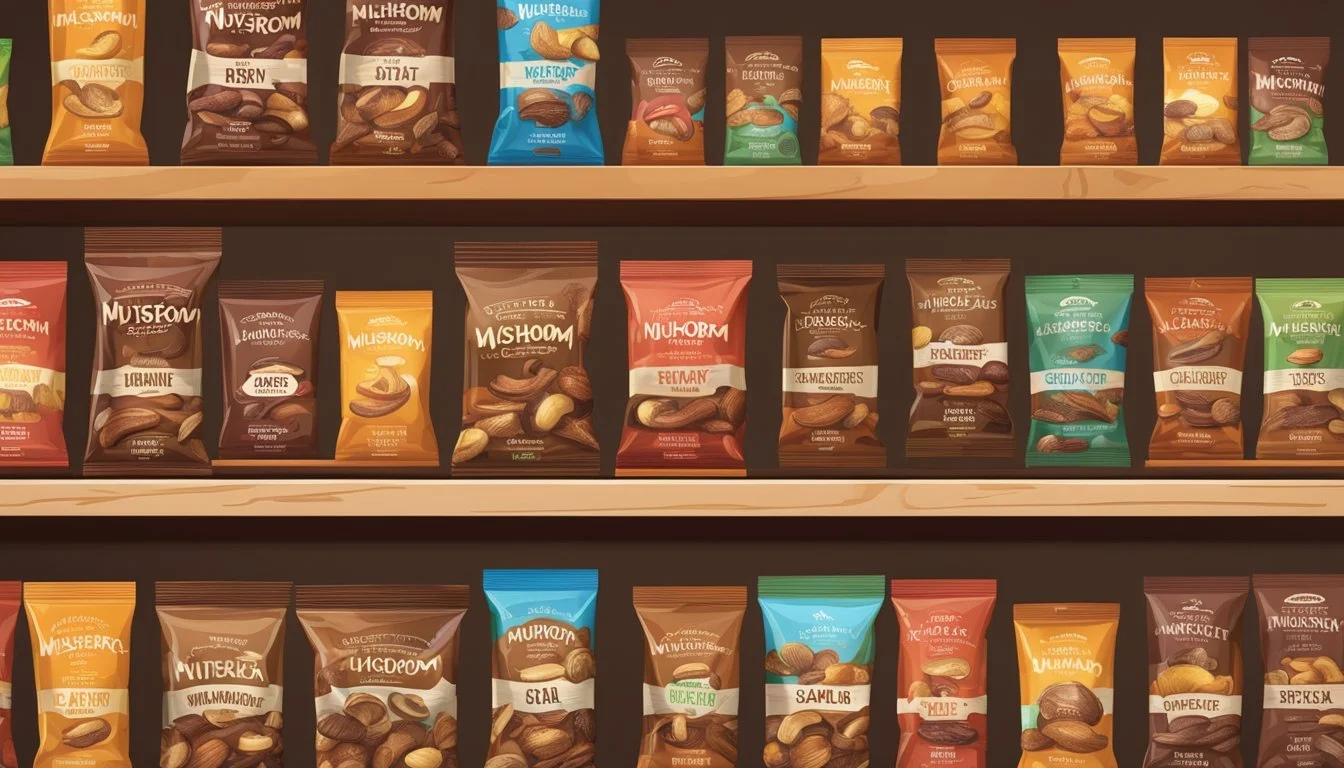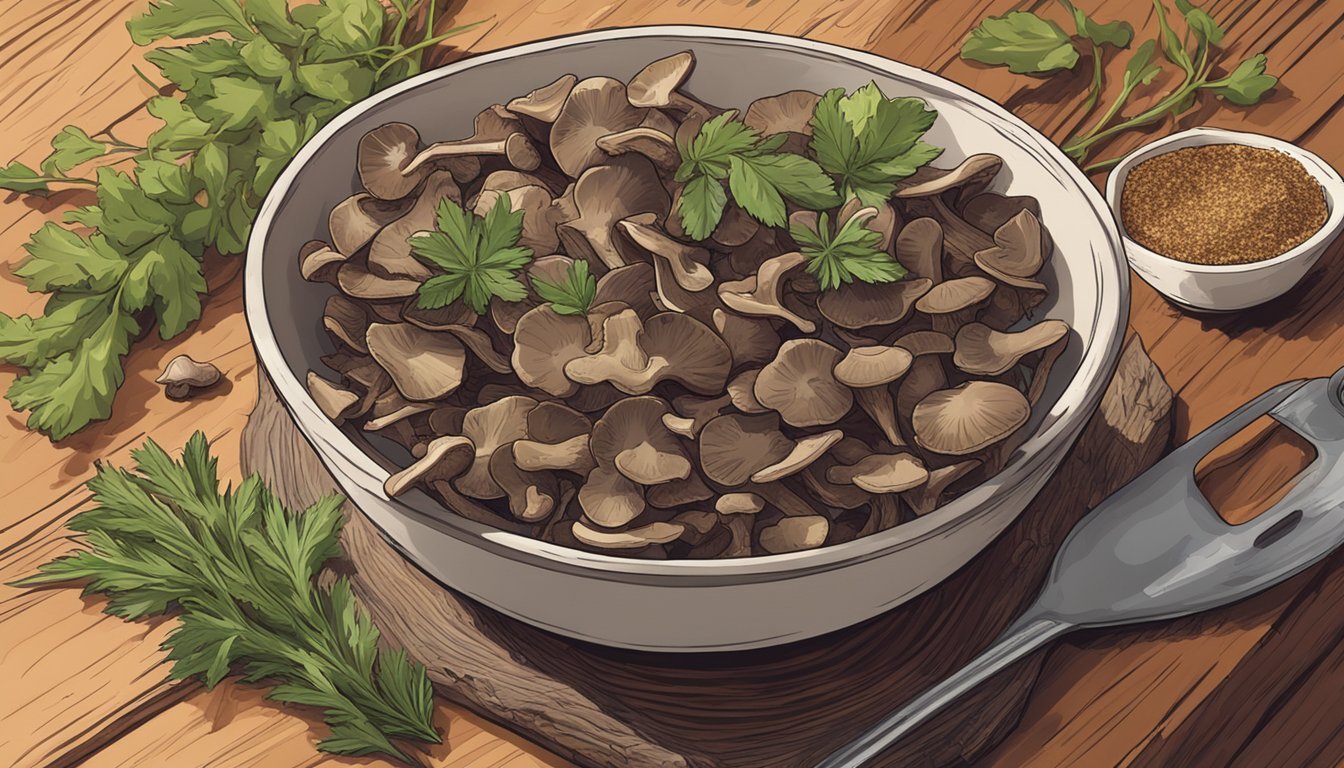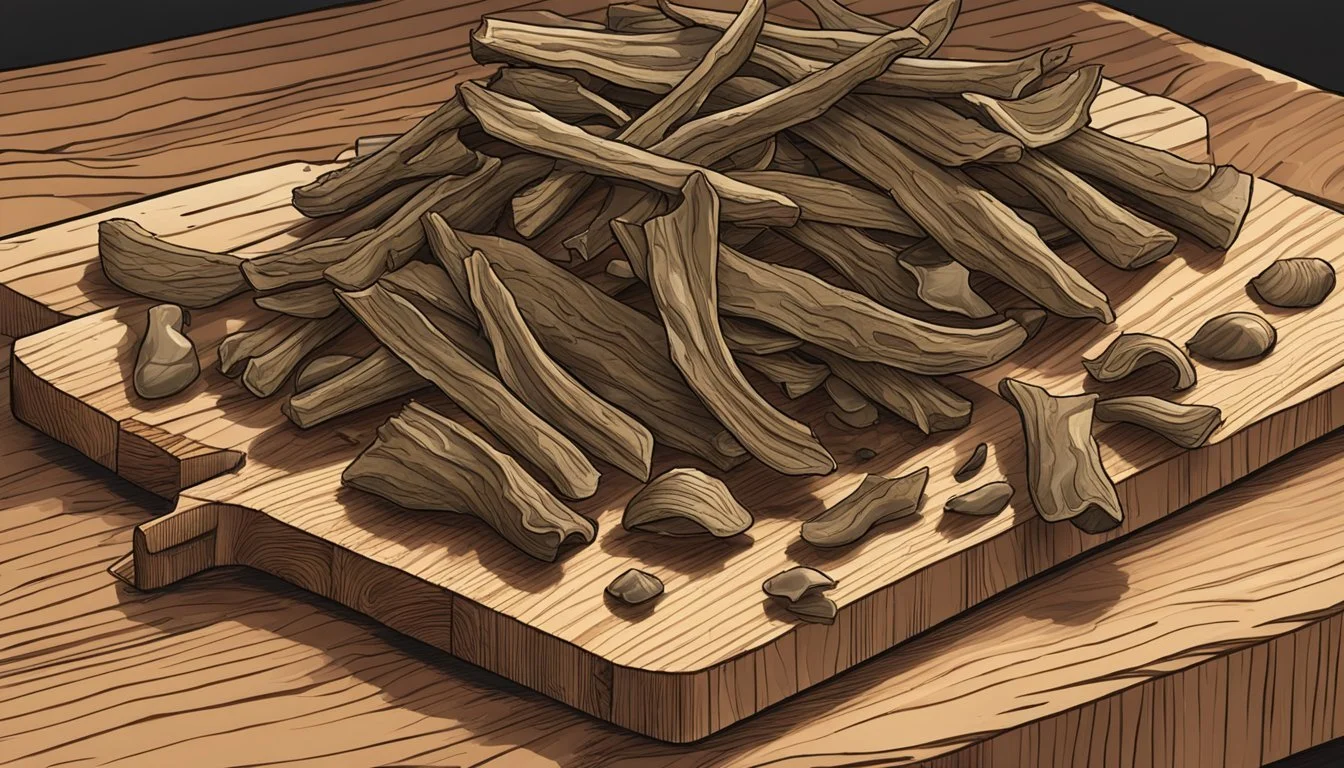Mushroom Stem Jerky
A Savory, Chewy Snack Revolutionizing Plant-Based Eating
Mushroom stem jerky is emerging as a savory snack that offers a chewy texture and a robust flavor profile. As a plant-based alternative to traditional beef jerky, it utilizes the often-overlooked stems of mushrooms (What wine goes well with mushrooms?), turning them into a delectable treat. The process involves marinating the stems in a blend of seasonings that can vary according to personal preference, infusing them with an umami-rich taste that rivals that of meat-based jerky.
This snack is not only tasty but also aligns with a variety of dietary choices, including vegan and gluten-free diets, depending on the specific ingredients used in the marinade. The preparation method is straightforward, typically involving marinating the mushroom stems for an extended period to deeply penetrate the fibers of the stems with flavor before they are dried using a low-temperature oven or dehydrator.
As health-conscious consumers search for nutritious snacks (What wine goes well with snacks?) that do not compromise on flavor, mushroom stem jerky stands out. It is rich in dietary fiber, vitamins, and minerals inherent in mushrooms, while also being lower in fat and free from the preservatives often found in conventional jerky products. This makes mushroom stem jerky an excellent option for those looking for a nourishing and satisfying snack.
Overview of Mushroom Varieties
Mushroom enthusiasts have a wide variety of mushrooms to choose from for making jerky, each with its unique flavor and texture profile. The most popular cultivated mushrooms include Shiitake and Portobello, while wild varieties such as Chanterelles and Porcini are foraged for their distinct tastes.
Shiitake Mushrooms
Shiitake mushrooms (Lentinula edodes) are renowned for their rich, savory flavor and meaty texture, which makes them ideal for jerky. They are typically cultivated on hardwood logs or sawdust and are a staple in Asian cuisines. Shiitake caps, when dried or turned into jerky, yield a umami-packed snack.
Portobello Mushrooms
Portobello mushrooms are actually fully grown Agaricus bisporus, the same species as the common button mushroom. Their large caps and dense, meaty texture are ideal for making jerky, providing a robust, earthy flavor. Portobello mushrooms are widely cultivated and easily accessible.
Oyster Mushrooms
Oyster mushrooms, or Pleurotus ostreatus, are named for their oyster-shaped caps and mild, anise-like flavor. This variety is thinner and less dense than some other types, creating a lighter, more delicate jerky texture. They grow in shelf-like formations and are found both wild and cultivated.
King Oyster and Hen of the Woods
King Oyster mushrooms (Pleurotus eryngii) are the largest in the oyster family and boast a firm texture and savory taste, suitable for creating hearty jerky pieces. Hen of the Woods, or Grifola frondosa, known also as Maitake, offer a rich and woodsy flavor that can add complexity to jerky.
Chanterelles and Porcini
Chanterelles and Porcini mushrooms are prized wild varieties. Chanterelles (Cantharellus cibarius) are known for their vibrant yellow color and subtly peppery taste. Porcini mushrooms (Boletus edulis), also called cepes, have a nutty, earthy flavor that intensifies when dried, making them desirable for jerky.
Benefits of Mushroom Jerky
Mushroom stem jerky emerges as a nutritious and satisfying option for snacking, integrating unique flavors and catering to various dietary preferences.
Nutritional Value
Mushroom jerky is rich in essential nutrients, making it a power-packed snack. It typically contains fiber, which aids in digestion, and protein, necessary for body repair and muscle growth. This snack also provides a notable umami flavor, a savory taste that satiates the palate. Many varieties are low in sodium yet rich in potassium, which supports heart health. They often contain vitamin D and selenium, crucial for immune function, as well as a range of B vitamins that are vital for energy production. Furthermore, mushrooms are known for their antioxidants, compounds that help protect the body from oxidative stress.
Vegan and Plant-Based Qualities
For those following a vegan or plant-based diet, mushroom jerky is an excellent snack choice. It's made without animal products, aligning with dietary restrictions and ethical considerations. This jerky provides a chewy texture similar to traditional beef jerky, making it a satisfying plant-based alternative. With its meaty taste and texture, it adds variety to a vegan diet, contributing to its adaptability and appeal.
Convenience of Mushroom Jerky
As a snack, mushroom jerky offers convenience. It's portable and has a long shelf life, making it suitable for on-the-go lifestyles, outdoor activities, or as a desk-side snack. It doesn't require refrigeration and is easy to pack, ensuring that a healthy snack option is always within reach. Busy individuals or those seeking nutritious, fuss-free nibbles will find mushroom jerky to be an agreeable choice.
Preparing Mushrooms for Jerky
Proper preparation of mushrooms is crucial for achieving the ideal texture and flavor in mushroom stem jerky. It involves selecting the best mushrooms and ensuring they are cleaned and cut to perfection.
Choosing the Right Mushrooms
When crafting mushroom jerky, opting for varieties with a meaty texture is essential for a result similar to traditional beef jerky. Varieties such as shiitake or portobello are ideal due to their thicker flesh and robust flavor. Their stems offer a dense texture that holds up well during the drying process.
Cleaning and Slicing Mushrooms
To begin, clean the mushrooms by gently wiping them with a damp cloth. It is not advisable to soak them, as they can become waterlogged and affect the dehydration process. Once cleaned, remove the stems from the caps.
Step Description Stem Removal Carefully detach stems from caps, setting caps aside for other uses. Slicing Stems Slice stems into uniform pieces, about 1/4 inch thick, to ensure even drying.
Uniform slicing is key to consistent drying and texture. After slicing, the mushroom stems are ready to be marinated, which will impart deep flavors and aid in creating a savory and chewy mushroom jerky.
Mushroom Jerky Marinades
Crafting a delicious marinade is essential for infusing mushroom jerky with rich flavors and achieving the perfect savory and chewy snack.
Basic Ingredients for Marinade
The foundation of any mushroom jerky marinade includes soy sauce or tamari for salty depth, oil to help with the dehydration process, and vinegar or citrus juice to tenderize and add tang. For sweetness, maple syrup or brown sugar can be balanced against the saltiness. Garlic or garlic powder contributes a pungent kick, and black pepper adds a sharp, woody note. To imbue a smoky taste without an actual smoker, a hint of liquid smoke works well.
Basic Ingredient Function Soy Sauce/Tamari Adds saltiness and umami Oil Aids the dehydration process Vinegar/Citrus Juice Tenderizes and adds acidity Sweeteners Counteracts and balances saltiness Garlic Provides a strong, aromatic flavor Black Pepper Introduces a sharp, woody note Liquid Smoke Gives a smoky flavor
Flavor Variations and Substitutions
To personalize marinades, an array of spices and seasonings can be employed. Smoked paprika or cayenne powder can be added for a hint of heat and smokiness, while red pepper flakes offer a spicy kick. Apple cider vinegar can replace malt or rice vinegar for a fruitier tang. Low sodium soy sauce or coconut aminos are excellent substitutes for those watching their salt intake. For a unique sweetness, honey or agave syrup are substitutes for maple syrup. Worcestershire sauce or sesame oil might be included for an additional layer of complexity. Mustard adds a tangy sharpness, and sriracha brings both heat and a touch of sweetness. Lime juice can bring a zesty freshness, contrasting the rich umami.
Remember, substitutions are always an option: rice wine vinegar or rice vinegar can be used instead of apple cider vinegar, and liquid aminos can be a stand-in for soy sauce. Adjust amounts according to taste preference and desired flavor intensity.
Flavoring Substitutions Paprika Smoked Paprika, Cayenne Powder Vinegar Apple Cider Vinegar, Rice Wine Vinegar Soy Sauce Low Sodium Soy Sauce, Coconut Aminos Sweetener Honey, Agave Syrup Citrus Lime Juice Exotic seasonings Worcestershire Sauce, Sesame Oil, Sriracha
Dehydration Techniques
Mushroom stem jerky benefits significantly from proper dehydration, an essential step in achieving the desired texture and concentration of flavors. There are two primary methods to dehydrate mushrooms for jerky: using a dedicated food dehydrator or a conventional oven.
Using a Dehydrator
A food dehydrator provides a controlled environment to efficiently dry out mushroom stems. Users should:
Prepare: Place the marinated mushroom stems in a single layer on the dehydrator trays.
Dehydrate: Set temperature to about 100°F (37.8°C).
Duration: Typically, the process takes 4 to 6 hours.
Check and Rotate: For even dehydration, rotate the trays 180 degrees halfway through.
Dryness: The stems are done when they exhibit a leathery, chewy texture and are no longer damp.
Using an Oven
For those without a dehydrator, a conventional oven can be utilized, with:
Preheat: Set to the lowest heat setting, ideally around 150°F (65.6°C).
Line Trays: Place marinated stems on a baking sheet lined with parchment paper.
Convection Setting: If available, use to improve air circulation.
Door Ajar: Keep the oven door slightly open to allow moisture to escape.
Time: It generally requires 4 to 6 hours to properly dehydrate, depending on thickness.
After dehydration, mushroom stem jerky must be stored in an airtight container to maintain freshness and texture. Whether using a dehydrator or an oven, attention to temperature and drying time is crucial for creating the perfect savory, chewy snack.
Storing Mushroom Jerky
When it comes to preserving the texture and flavor of mushroom jerky, proper storage is key. They should store their mushroom jerky in an airtight container to protect it from moisture and air, which can quickly degrade its quality.
Refrigerator Storage
For short-term storage, one can place the jerky in a refrigerator where it will maintain its quality for about two weeks. When storing in the refrigerator, they should ensure the jerky is sealed in an airtight container or resealable plastic bag to prevent the absorption of other flavors and moisture.
Short-term: Refrigerate in an airtight container for up to 2 weeks.
Freezing
For long-term storage, freezing mushroom jerky is an excellent option. One should wrap the jerky pieces in parchment paper first to prevent them from sticking together, then seal them in an airtight container or freezer bag. They can label the container with the date to keep track of its storage time. Properly frozen, mushroom jerky can last several months.
Long-term: Freeze wrapped in parchment, then in an airtight container for several months.
Here is a breakdown of the ideal storage methods:
Storage Method Container Type Duration Refrigerator Airtight Container Up to 2 weeks Freezer Freezer Bag/Airtight Container Several Months
One should always check their mushroom jerky before consuming, especially if it has been stored for an extended period. Any signs of spoilage, such as mold or an off odor, indicate that the jerky is no longer safe to consume.
Creative Ways to Enjoy Mushroom Jerky
Mushroom jerky is a delicious and versatile snack that can be enjoyed straight from the bag or used as an ingredient to elevate various dishes. Its savory and chewy nature makes it a satisfying treat, catering to both savory snack lovers and culinary adventurers.
As a Snack
Mushroom jerky serves as a perfect on-the-go snack. For a nutritional boost, it can be paired with:
Nuts and seeds: A handful of almonds or pumpkin seeds adds crunch and nutrients.
Cheese: Small slices of cheese can complement the umami flavor of the jerky.
Dried fruits: Balance the savory with the sweet for a fuller flavor experience.
On its own, mushroom jerky preserves the earthiness of mushrooms and delivers a satisfying chew, making it an exemplary standalone snack.
Incorporating into Dishes
One can integrate mushroom jerky into meals to infuse a depth of flavor. Here are a few ideas:
Salads: Chop the jerky into bite-sized pieces and sprinkle over salads for added texture.
Soups and Stews: Dice and drop into soups or stews, allowing them to rehydrate and impart a smoky, meaty essence.
Grains and Pasta: Enhance rice, quinoa, or pasta dishes by stirring through some chopped jerky.
The incorporation of mushroom jerky into recipes is seamless, as it easily absorbs surrounding flavors while contributing its own rich taste profile.
Homemade vs Store-Bought
When considering mushroom stem jerky, one has the choice between crafting it at home or opting for the convenience of store-bought varieties. Homemade mushroom jerky allows for full control over the ingredients, ensuring a vegan and gluten-free snack. The process involves slicing the stems, marinating with seasonings of choice, and then dehydrating. This tends to result in a jerky free from preservatives, aligning with those seeking a more natural diet.
The store-bought version is effortlessly accessible and time-saving. It's ideal for those with a busy lifestyle or without the equipment to dehydrate food at home. However, consumers should be wary, as some products may contain preservatives to extend shelf life.
Aspect Homemade Mushroom Jerky Store-Bought Mushroom Jerky Ingredients Customizable, can be pure and natural May include additives and preservatives Convenience Requires time and equipment Readily available, no preparation needed Dietary Needs Can cater to vegan, gluten-free diets Check labels for dietary compliance Flavor Freshness of ingredients can enhance flavor Standardized flavors Nutritional Value No preservatives, potential for higher nutritional benefit Preservative use may impact health attributes
Vegan mushroom jerky made at home is generally considered easy to make. It involves marinating the mushrooms in a savory concoction—tamari, vinegar, syrup, and spices are common—then baking or dehydrating. The result is a chewy, flavorful snack tailored to personal taste preferences.
Those interested in the nutritional side and ingredient transparency may lean towards homemade options, while individuals seeking immediacy might prefer the store-bought route.
Enhancing Mushroom Jerky Recipes
To elevate homemade mushroom jerky, one can experiment with texture and flavor profiles as well as fortify it with additional nutrients. These enhancements not only improve taste but also contribute to the snack's health benefits.
Texture and Flavor Enhancements
Achieving the perfect chewiness coupled with a burst of flavor can transform mushroom jerky into a gourmet treat. Here are specific ways to achieve that goal:
Marination: Thoroughly marinate the mushrooms in a mixture including olive oil to attain a succulent texture. Olive oil also helps in evenly distributing flavors.
Sweeteners: Incorporate natural sweeteners such as honey or maple syrup into the marinade for a delicate balance of sweetness that complements the savory notes.
Spices: Infuse spices like ginger and onion powder to add a subtle warmth and depth to the flavor profile.
Nutrient Boosters
Mushroom jerky can serve as a nutritious snack when amplified with the following nutrient-rich ingredients:
Olive Oil: Using olive oil not only enhances flavor but also contributes healthy fats and vitamin E.
Honey: Aside from sweetness, honey can add antioxidants to the jerky.
Ginger: Known for its anti-inflammatory properties, ginger can offer digestive benefits when included in the recipe.
By incorporating these enhancements, mushroom jerky becomes a more enjoyable and nutritious snack option.
Conclusion
Mushroom jerky offers a delightful alternative to traditional meat jerky, providing both vegetarians and meat-eaters with a savory snack that is simple to make at home. Through the careful preparation of this unconventional jerky, individuals can enjoy a satisfying chewy texture coupled with a rich umami flavor.
Ease of Preparation: With a straightforward recipe that involves marinating and slow-baking or dehydrating, mushroom jerky can be made with minimal kitchen equipment. It is accessible for beginners and enjoyable for experienced cooks to experiment with a variety of flavors and mushroom types.
Health Benefits: Mushroom jerky is not only a satisfying snack but also a healthier option packed with nutrients. Mushrooms are known for their beneficial properties, including high levels of vitamins, minerals, and fiber.
Versatility in Flavor: The recipe allows for customization with an array of spices and marinades. The resulting jerky can range from sweet and tangy to spicy and bold. An adept cook can adjust the marinade ingredients to cater to different palates and dietary restrictions.
In summary, mushroom stem jerky stands out as an innovative, nutritious, and versatile snack. It is ideal for those seeking to incorporate more plant-based options into their diet without compromising on taste or texture. As popularity grows, this snack continues to charm snack enthusiasts with its depth of flavor and ease of making.

